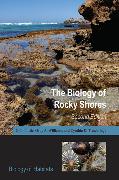- Start
- The Biology of Rocky Shores
The Biology of Rocky Shores
Angebote / Angebote:
Successful first edition, thoroughly revised and updated with expanded coverage of topical materialTheme-based approach in line with current teaching practiceNew section on techniques and experimental approaches with suggestions for student-based project workConcise and affordable overview providing a complete coverage of the fieldGlobal range of examples promotes international appealExamines the entire range of biota (microbes, invertebrates, plants and vertebrates) in the context of their physical environment New to this editionThis second edition adds several dimensions to the first, by incorporating the expertise of two new authors, one based in Hong Kong, the other in USA. Since the original edition in 1996, views of how rocky shore communities are regulated have changed, and the book discusses these changes. It is no longer limited to the north-west Atlantic, but covers rocky shores worldwide. It discusses the diversity of shore organisms in terms of functional groups, and it now gives a detailed account of how organisms have adapted to the physical constraints of living on rocky shores. It provides advice on methods and experimental approaches. Black and white photographs and many new line drawings have been added to the original figures.Text is 80% new, illustrations 50% This new edition offers a concise but comprehensive introduction to rocky shore ecology and has been completely revised and updated throughout. It describes the diverse biota (invertebrates, vertebrates, seaweeds, seagrasses and microalgae) that inhabit rocky shores, and the factors that determine their distributions, abundances and interactions. The book discusses the latest research on processes that control community structure, utilizing a global range of examples from a wide range of shore types - both temperate and tropical.The Biology of Rocky Shores begins by describing the shore environment, including the conditions caused by tidal rise and fall as well as an introduction to the effects of waves. It goes on to describe the biodiversity of the rocky shore environment, from seaweeds and cyanobacteria to starfish and oystercatchers, and some of the adaptations these organisms exhibit on the shore. The book discusses in turn the biology of primary producers, grazers, suspension feeders and predators, and the ways in which these trophic groups interact in various communities. The vertical and horizontal distributions of species in relation to the tidal cycle and wave exposure are also considered. The contributions that species make in determining how rocky-shore communities function, and how they interact with off-shore systems, are explored in detail. Human influences, notably pollution, over-fishing and the introduction of alien species, are discussed in the context of rocky shore conservation and future management strategies. A final chapter offers guidance on methods of study, techniques, and experimental approaches.
Fremdlagertitel. Lieferzeit unbestimmt
